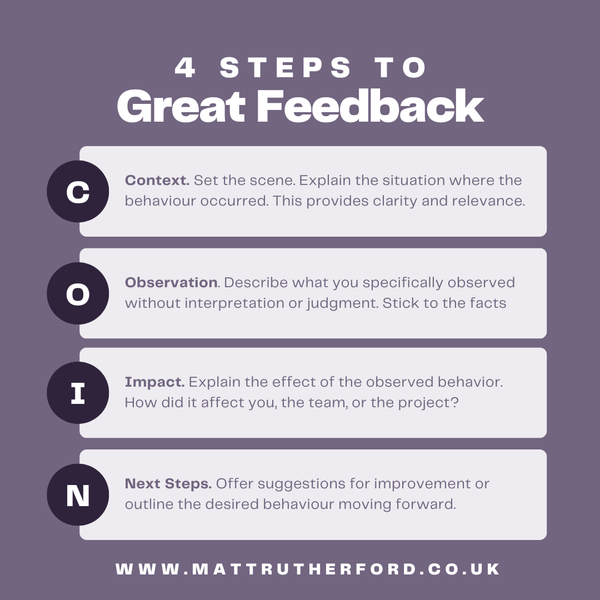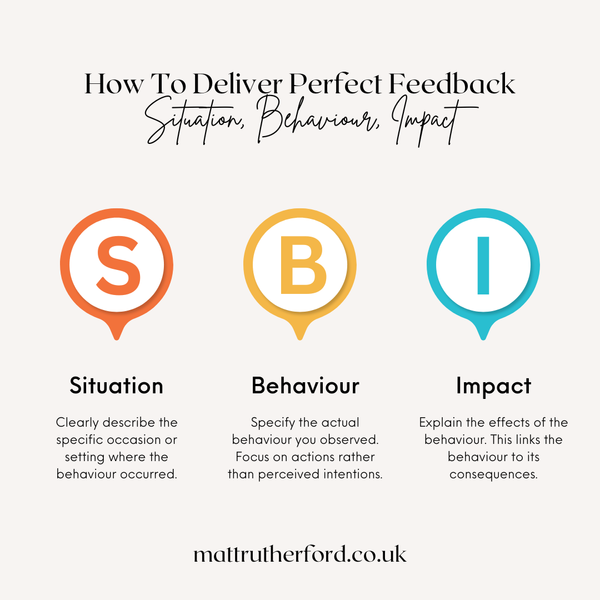In previous posts, I’ve shared some top frameworks for giving great feedback. However, it is as important to know how to handle feedback and build trust with people around you. I’ve captured some key tips that will help you develop your skills for receiving feedback.
Feedback is crucial for growth, but it can be difficult to hear, especially when it’s critical. Developing the ability to accept feedback and act on it can be a game-changer for your career progress.
These tips will help you learn how to receive feedback in a way that enhances your professional growth.
1. Change Your Perspective: Feedback is a Tool, not a Threat
The first step to receiving feedback well is framing how you think about it. Instead of seeing feedback as a judgement on your abilities or personality, recognise that it’s simply information. When used correctly, it can be an effective tool to help you reach your goals.
View feedback as a gift for improvement, not a personal attack.
2. Don’t Take It Personally
When feedback touches on areas for improvement, it’s easy to feel defensive. However, it’s important to separate feedback from your sense of self. It’s not an attack on your character, it’s an opportunity to grow in a specific area.
Keep this distinction in mind to prevent emotional reactions from clouding your judgement.
Remember that feedback is about specific actions or behaviours, not your overall worth.
3. Create Psychological Safety for Honest Feedback
One of the most overlooked aspects of receiving feedback is creating an environment where people feel safe to be honest. If you tend to react defensively, people may hesitate to give you the feedback you need.
By staying calm, asking for clarification, and showing gratitude, you’ll make it clear that you’re open to hearing constructive comments.
Foster an atmosphere of psychological safety by showing you can receive feedback without reacting negatively. This encourages more honest and useful feedback in the future.
4. Listen Fully Before Responding
When feedback is given, our natural reaction is often to explain ourselves, defend our actions, or even dismiss what’s being said.
Instead, focus on active listening before responding. Absorb the feedback without interrupting. It’s crucial to understand the other person’s perspective before you form a response.
Be an active listener—hear the full feedback before responding.
5. Seek Clarification When Needed
If the feedback you receive is unclear, don’t hesitate to ask for more specifics. Requesting examples or further explanation can help you understand the feedback better and ensure you know what areas need improvement. For instance, asking “Can you give me an example of when that happened?” can provide more context and direction.
Don’t be afraid to ask follow-up/probing questions to ensure clarity.
6. Acknowledge and Appreciate the Feedback
Whether the feedback is positive or constructive, always acknowledge it. Thank the person for their time and effort in providing you with insights.
Creating this positive feedback loop shows that you value their input, making them more likely to offer valuable feedback in the future.
Saying “thank you” is simple and powerful and can encourage further honesty and openness.
7. Take Time to Reflect
Feedback doesn’t need to be acted upon immediately. Give yourself time to reflect on what was said.
Think about how the feedback aligns with your goals and how it can be used to improve your skills or behaviours. This will also help you respond in a thoughtful, rather than reactive, manner.
Allow yourself time to process and reflect before acting on the feedback.
8. Turn Feedback into an Action Plan
The real value of feedback lies in what you do with it. Once you’ve had time to reflect, create a specific action plan to address the areas for improvement. Break down the feedback into smaller, actionable steps. Whether it’s changing a habit, adopting a new strategy, or seeking out additional training, having a plan will help you turn feedback into growth.
Create a clear plan to address the feedback and track your progress.
9. Ask for Follow-Up Feedback
Feedback is most effective when it’s part of an ongoing conversation. After implementing changes based on the feedback you’ve received, follow up and ask for further feedback on your progress. This demonstrates your commitment to improvement and keeps the lines of communication open.
Request follow-up feedback to monitor your progress and maintain continuous improvement.
10. Filter Feedback with Discernment
Not all feedback will be equally valuable. While staying open to feedback is crucial, it’s also important to evaluate the source and relevance of the comments you receive.
Consider whether the feedback aligns with your goals and if the person providing it has enough context to offer meaningful insights.
Be open to feedback, but know when to filter out advice that doesn’t serve your growth.
How to Use Feedback to Fuel Growth
Receiving feedback effectively isn’t just about listening to what’s being said, it’s about creating an environment where people feel comfortable sharing, understanding the value of the feedback, and then turning it into actionable steps for growth.
By shifting your mindset and developing these skills, feedback can become one of the most powerful tools in your professional toolkit.
Remember, the most successful people are those who actively seek feedback and know how to use it to continually evolve. With the right approach, you can turn any piece of feedback into a stepping stone towards success.
Key Takeaways:
- View feedback as a tool for growth, not as a personal criticism.
- Listen fully before reacting or responding.
- Create psychological safety so people feel comfortable giving honest feedback.
- Show gratitude for the feedback you receive.
- Take time to reflect before taking action.
- Develop an action plan based on the feedback.
- Ask for follow-up feedback to track your progress.
Feedback is a continuous process, and by mastering how to receive it well, you can ensure you remain on a path of improvement.





Member discussion